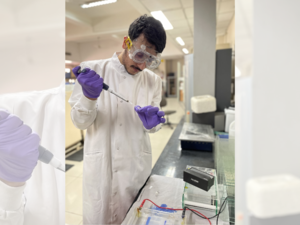-
WASHINGTON: India Now Second-Largest Source Country For New Citizens In US- Report - 8 hours ago
-
LONDON: Indian-Origin Teen In UK Gets “Life-Changing” Cancer Treatment - April 25, 2024
-
SILICON VALLEY: All About Pavan Davuluri, New Head Of Microsoft Windows - April 25, 2024
-
LONDON: UK’s India Gate To Commemorate Role Of Indian Soldiers From World Wars - April 24, 2024
-
HARARE: Shri Bramha Kumar appointed as the next Ambassador of India to the Republic of Zimbabwe - April 23, 2024
-
LONDON: Indian-Origin Principal Wins UK Legal Challenge Over School Prayer Ban - April 23, 2024
-
TORONTO: Indian-Origin Doctor Needs ₹ 2 Crore For Legal Fees. Elon Musk Responds - April 22, 2024
-
KINSHASA: India-Democratic Republic of Congo Foreign Office Consultations - April 21, 2024
-
LONDON: UK Court Allows Sale Of Nirav Modi’s Luxury London Apartment - April 21, 2024
-
TEHRAN: Travel advisory for Iran and Israel - April 20, 2024
BENGALURU: IISc team finds way to block a superbug transporter
BENGALURU: Researchers from the Indian
Institute of Science’s (IISc) Molecular Biophysics Unit (MBU) have found a
novel way to block bacteria from flushing out antibiotics which helps them gain
drug resistance.
The new finding holds the potential of making existing drugs more effective
against drug resistant bacteria or superbugs.
What they’ve essentially done is use a specific antibody found in Indian camels
(at the National Research Centre on Camel, Bikaner) to block a transporter that
helps bacteria flush out drugs. At present, the team, led by Aravind Penmatsa,
assistant professor at MBU, has demonstrated the finding in laboratory
conditions.
Bacteria are generally killed by the use of antibiotics. One of the mechanisms
they use to gain resistance is called efflux — the process in which bacteria
transport compounds such as drugs outside the cell — and transporters play a
crucial role in enabling the pathogen to perform this.
That transporters are among major
components in the multidrug resistance armoury of bacteria, understanding the
molecular architecture of these cell membrane-embedded machines paves the way
for designing inhibitors against them, thereby helping in the treatment of
diseases caused by these bacteria.
And, according to IISc, in a new study, the researchers “have solved the
atomic-resolution structure of one such transporter, NorC, in complex with an
Indian camelid antibody (ICab).”
Though transporters are molecular machines that need to shift their
conformation (shape/structure) to transport substrates, the team found that the
binding of ICab to NorC locked it into a single conformation.
Not only did the transporter get locked in a single state, but the ICab
effectively plugged the transporter like a “bottle-cork”, rendering it
incapable of interacting with antibacterial compounds (drugs), the researchers
said.
“…The process of efflux is very
important for bacteria and one of the major strategies that hasn’t yet been
explored as a therapeutic mechanism is to develop molecules that can block
efflux. If we are able to block transporters that help efflux of certain
antibiotics, those drugs will gain efficacy. In some sense, we can enhance the
efficacy of available antibiotics if we have blockers of efflux and that’s the
potential medical benefit of what we’ve found,” Penmatsa told TOI.
NorC is a transporter found in
Staphylococcus aureus — a type of bacteria often found on the skin and in the
upper respiratory tract of humans — that helps provide resistance against
broad-spectrum antibiotics like norfloxacin and moxifloxacin.
“These insights will significantly help formulate strategies to counter
transporter-mediated antibiotic resistance in pathogenic bacteria, using tools
like camelid antibodies. The structure of NorC and the conformation it has been
solved in is also the first-of-its-kind, providing a model to study similar
drug efflux transporters from other pathogenic bacteria,” IISc added.
The study was primarily funded by the DBT-Wellcome Trust India Alliance
and the department of biotechnology.
























